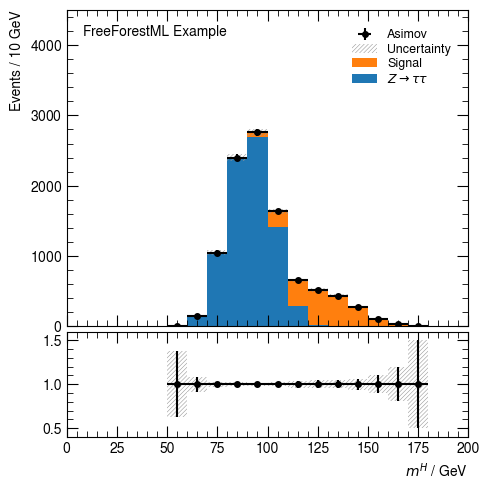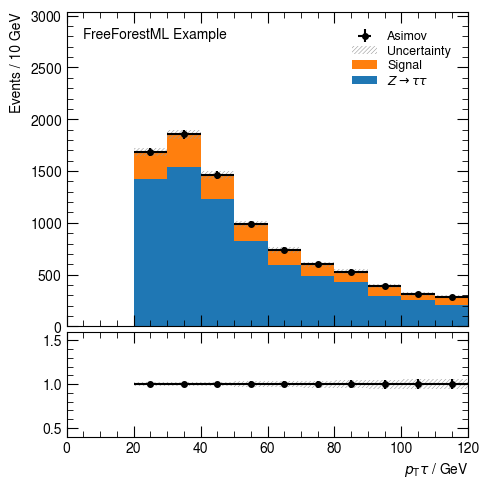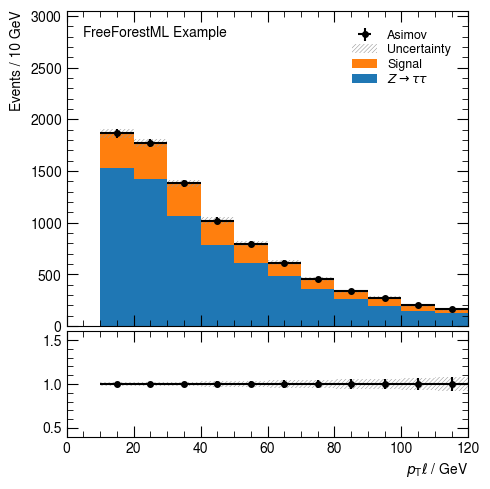Histogram Factory
The number of arguments passed to hist() is large and usually a source of code repetation. The HistogramFactory is a way to define default argument that can be overridded when creating a histogram.
[1]:
import pandas as pd
import seaborn as sns
from freeforestml import Variable, Process, Cut, hist, HistogramFactory, McStack, DataStack
from freeforestml import toydata, example_style
example_style()
2023-08-02 16:39:42.723123: I tensorflow/core/platform/cpu_feature_guard.cc:193] This TensorFlow binary is optimized with oneAPI Deep Neural Network Library (oneDNN) to use the following CPU instructions in performance-critical operations: AVX2 AVX512F FMA
To enable them in other operations, rebuild TensorFlow with the appropriate compiler flags.
2023-08-02 16:39:42.853325: W tensorflow/compiler/xla/stream_executor/platform/default/dso_loader.cc:64] Could not load dynamic library 'libcudart.so.11.0'; dlerror: libcudart.so.11.0: cannot open shared object file: No such file or directory
2023-08-02 16:39:42.853354: I tensorflow/compiler/xla/stream_executor/cuda/cudart_stub.cc:29] Ignore above cudart dlerror if you do not have a GPU set up on your machine.
2023-08-02 16:39:43.686927: W tensorflow/compiler/xla/stream_executor/platform/default/dso_loader.cc:64] Could not load dynamic library 'libnvinfer.so.7'; dlerror: libnvinfer.so.7: cannot open shared object file: No such file or directory
2023-08-02 16:39:43.687038: W tensorflow/compiler/xla/stream_executor/platform/default/dso_loader.cc:64] Could not load dynamic library 'libnvinfer_plugin.so.7'; dlerror: libnvinfer_plugin.so.7: cannot open shared object file: No such file or directory
2023-08-02 16:39:43.687050: W tensorflow/compiler/tf2tensorrt/utils/py_utils.cc:38] TF-TRT Warning: Cannot dlopen some TensorRT libraries. If you would like to use Nvidia GPU with TensorRT, please make sure the missing libraries mentioned above are installed properly.
Setup
Load or geneate toy dataset.
[2]:
df = toydata.get()
Define processes included in the histogram.
[3]:
p_ztt = Process(r"$Z\rightarrow\tau\tau$", range=(0, 0))
p_sig = Process(r"Signal", range=(1, 1))
p_asimov = Process(r"Asimov", selection=lambda d: d.fpid >= 0)
Define stacks. Data is it’s own stack and should not be stacked on top of the MC prediction.
[4]:
s_bkg = McStack(p_ztt, p_sig)
s_data = DataStack(p_asimov)
Examples
Create a default plotting method the has a default value for the dataframe, the stacks and the binning.
[5]:
hist_factory = HistogramFactory(df, stacks=[s_bkg, s_data], bins=20, range=(0, 200), selection=None,
weight="weight")
None
Create a plot for the mass variable. Note that we pass a single argument to the plotting method.
[6]:
v_mmc = Variable(r"$m^H$", "higgs_m", "GeV")
hist_factory(v_mmc)
None

Create a plot for different variables, also overriding the binning.
[7]:
v_tau_pT = Variable(r"$p_\mathrm{T}{\tau}$", "tau_pt", "GeV")
hist_factory(v_tau_pT, bins=12, range=(0, 120))
None

[8]:
v_lep_pT = Variable(r"$p_\mathrm{T}{\ell}$", "lep_pt", "GeV")
hist_factory(v_lep_pT, bins=12, range=(0, 120))
None
